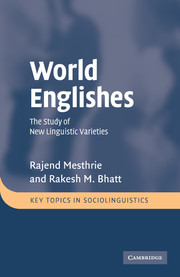Book contents
- Frontmatter
- Contents
- List of figures
- List of tables
- Preface
- Acknowledgements
- List of abbreviations
- 1 History: the spread of English
- 2 Structural features of New Englishes I: morphology and phrasal syntax
- 3 Structural features of New Englishes II: cross-clausal syntax and syntactic theory
- 4 More on structure: lexis and phonology
- 5 Pragmatics and discourse
- 6 Language contact and language acquisition issues in New English research
- 7 Conclusion: current trends in the spread of English
- Glossary
- Bibliography
- Author index
- Subject index
2 - Structural features of New Englishes I: morphology and phrasal syntax
Published online by Cambridge University Press: 05 September 2012
- Frontmatter
- Contents
- List of figures
- List of tables
- Preface
- Acknowledgements
- List of abbreviations
- 1 History: the spread of English
- 2 Structural features of New Englishes I: morphology and phrasal syntax
- 3 Structural features of New Englishes II: cross-clausal syntax and syntactic theory
- 4 More on structure: lexis and phonology
- 5 Pragmatics and discourse
- 6 Language contact and language acquisition issues in New English research
- 7 Conclusion: current trends in the spread of English
- Glossary
- Bibliography
- Author index
- Subject index
Summary
This chapter provides an overview of the main syntactic and morphological characteristics of New Englishes (i.e. mainly ‘Outer Circle’ varieties). The main focus will fall upon their recurrent features, though some rarer constructions, limited to one or two varieties, will also be discussed where relevant.
A NOTE ON METHOD
Our focus in this chapter is largely descriptive, seeking to establish similarities amongst the recurrent features of New Englishes. In Chapter 6 we examine the broader questions raised by these similarities and the attempts that have been made to tie them together within particular analytic and theoretical frameworks. We begin with an excursus on methodology.
This chapter, like the rest of the book, is reliant upon individual descriptions of World Englishes occurring in journals, monographs devoted to individual countries and overviews found in handbooks. Ideally, before linguistic generalisations can be made, we should be sure that we are comparing varieties and sub-varieties that are indeed comparable. Broadly speaking this means being mindful of the ESL–EFL distinction, as well as of the somewhat special status of what we called ‘language-shift varieties’ (see section 1.2). It also means comparing appropriate subgroups of speakers, paying attention to differences between users still learning the local variety of English and those who are competent users who have already acquired it. This distinction is perhaps not as clear-cut as it may first appear, given the principle of lectal shifting.
- Type
- Chapter
- Information
- World EnglishesThe Study of New Linguistic Varieties, pp. 39 - 77Publisher: Cambridge University PressPrint publication year: 2008

